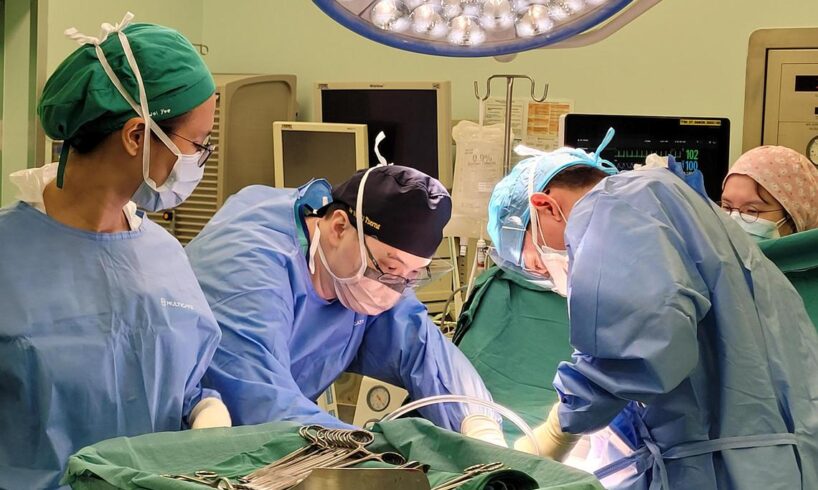
SINGAPORE – A trauma care model fashioned after the wheel of a bicycle has been launched in the central region of Singapore to improve the outcomes of patients with life-threatening injuries.
The hub-and-spoke concept increases the chances of critically injured patients receiving optimal care at the most appropriate hospital, ultimately leading to faster response times and reduced death rates.
Tan Tock Seng Hospital’s (TTSH) Trauma Centre serves as the hub, specialising in the most complex and critical cases, while the other hospitals in central Singapore act as the spokes, managing moderate to less severe trauma patients.
The “spoke hospitals” comprise Khoo Teck Puat Hospital, Woodlands Health (WH), Sengkang General Hospital (SKH), Raffles Hospital and KK Women’s and Children’s Hospital, which are from different healthcare clusters.
The model also helps to “maximise resources… since four of the eight specialist trauma surgeons in Singapore are located at TTSH”, Dr Teo Li Tserng, director of the TTSH Trauma Centre, told reporters at an interview on July 16.
The rest of the specialist trauma surgeons are based at three other hospitals.
Dr Teo said patients requiring care based on a set of tailored secondary transfer criteria are sent to the hub.
The transfer criteria include specialised care that is not readily available at the referring hospital; specific medical conditions, such as severe injuries; specialised monitoring; and communication difficulties.
The care model was shared at the Singapore Trauma and Acute Care Conference 2025, which is being held at the Suntec Singapore Convention and Exhibition Centre from July 17 to 18.
Trauma is a form of injury caused by an external force. Many such patients suffer multiple injuries or damage in multiple regions, whether from traffic accidents, bad falls or penetrating wounds.
It ranks among the top 10 causes of death in Singapore, with falls and road accidents being the leading causes of moderate to severe trauma injuries.
According to the National Trauma Registry, there were about eight trauma cases per 100,000 population treated at the public healthcare institutions daily between 2021 and 2023, with almost seven in 10 of the moderate to severe cases involving the elderly aged 65 and above.
About one in five patients with severe trauma did not survive, and one in 50 with moderate trauma died.
Although the hub-and-spoke trauma care model is not a new idea, the one here has a “bi-directional patient flow”, setting it apart from existing ones elsewhere.
“Unlike most uni-directional systems where the hub takes every trauma case first, our model allows for a critically injured victim of, say, a bad road accident, to be taken to the nearest (spoke) hospital to be stabilised before transferring him to the hub for the complex, life-threatening emergency treatment,” said Dr Teo, who is also regional director of the Central Region Trauma Services from NHG Health.
“Once emergency treatment is complete and the patient is stabilised, he can be transferred back to the spoke hospital for follow-up rehabilitation, or even to a hospital closer to his residence for ongoing care,” he added.
If the patient is not stable enough for transfer, surgeons from the hub can go to the periphery hospitals instead.
The bi-directional operation significantly reduces the burden on the main trauma centre at TTSH, making more efficient use of resources and “reflecting a right-sited, patient-centred approach”, Dr Teo added.
Using the analogy of a jar of kaya and several pieces of sliced bread, Dr Teo said: “The kaya in this case is finite, so how do we adequately spread it around to the increasing slices of bread or even concentrate the kaya to make sure that at least everybody gets enough for taste? That’s the challenge.
“We have to ensure that patients get adequate care to allow them the chance for survival.”
For the hub-and-spoke model to work, the Singapore Civil Defence Force plays a crucial role as its first responders decide where to transport patients based on the type and severity of their injuries, Dr Teo said.
“Even with Singapore’s small size and short transport times, that extra five minutes taking the critically injured patient to the hub is crucial for him to fare better,” he said.
The hub-and-spoke model is still being developed, as some hospitals in the central region are at “various stages of their maturity”, said Dr Teo, who pointed out that Sengkang Hospital and Woodlands Health are the two newest hospitals.
In comparison, the TTSH Trauma Centre has been working with Sengkang Hospital since 2016.
“We are trying to fully roll this (model) out by September, and, hopefully, it will then be the prototype for the rest of the healthcare groups to adopt,” Dr Teo said.





